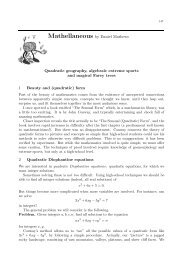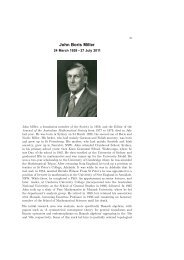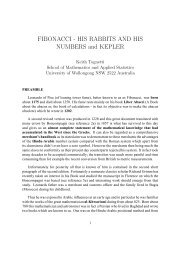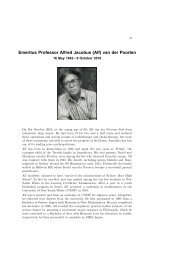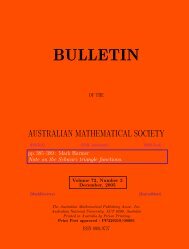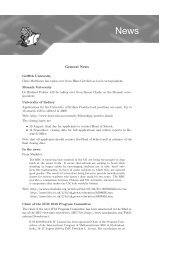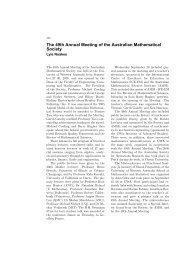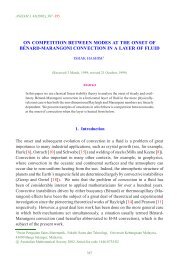Gazette 31 Vol 3 - Australian Mathematical Society
Gazette 31 Vol 3 - Australian Mathematical Society
Gazette 31 Vol 3 - Australian Mathematical Society
Create successful ePaper yourself
Turn your PDF publications into a flip-book with our unique Google optimized e-Paper software.
abelian theta functions, which might have<br />
been the original intention of the author.<br />
Nevertheless I think the book provides a<br />
useful summary of the theory, and it is commendable<br />
that the author’s colleagues have<br />
brought the draft manuscript to completion.<br />
It definitely stimulated my own interest in<br />
the field.<br />
References<br />
[1] A. Beauville, Vector bundles on curves and<br />
generalized theta functions: recent results and<br />
open problems, Current Topics in Complex<br />
Algebraic Geometry (Berkeley CA 1992/93),<br />
Math. Sci. Res. Inst. Publ. 28 (Cambridge University<br />
Press Cambridge 1995), 17–33.<br />
[2] A. Tsuchiya and Y. Kanie, Vertex operators in<br />
conformal field theory on P 1 and monodromy<br />
representation of braid group, Adv. Stud. Pure<br />
Math. 16 (Academic Press Boston 1988), 297–<br />
372.<br />
Peter Bouwknegt<br />
Department of Theoretical Physics, RSPhysSE, and<br />
Department of Mathematics, MSI, The <strong>Australian</strong><br />
National University<br />
E-mail: peter.bouwknegt@anu.edu.au<br />
⋄ ⋄ ⋄ ⋄ ⋄ ⋄<br />
Regular neighbourhoods<br />
and canonical decompositions<br />
for groups<br />
Peter Scott and Gadde Swarup<br />
Astérisque<br />
Societé Mathématique de France 2003<br />
ISBN 2-85629-146-5<br />
Consider a closed orientable manifold M<br />
and a codimension one π1-injective submanifold<br />
N. Then N defines a splitting of<br />
G = π1(M) over H = π1(N) as an amalgamated<br />
product or HNN extension. When<br />
N is only immersed in M, then there is<br />
no splitting correponding to N. Instead,<br />
the algebraic object corresponding to this<br />
situation is what the authors call an Halmost<br />
invariant subset of G which should<br />
Book Reviews 207<br />
be thought as the analogue of a splitting in<br />
the case of an immersion.<br />
The goal of the authors is to generalize<br />
to finitely presented groups the JSJ decomposition<br />
of an orientable Haken 3-manifold<br />
M by Jaco-Shalen and Johannson. If M<br />
is a closed 3-manifold, this decomposition<br />
consists in a maximal disjoint union of nonparallel<br />
π1-injective embedded tori T having<br />
the property that any immersed torus of M<br />
can be homotoped to be disjoint with T.<br />
A central notion in this work is the notion<br />
of enclosing: consider T a disjoint union of<br />
submanifolds of M. If an immersion of N<br />
into M can be homotoped to M \T, then N<br />
is enclosed in the corresponding component<br />
of M \ N. This notion has a natural generalization<br />
saying when a H-almost invariant<br />
subset of G is enclosed in a vertex of a<br />
splitting of G. Enclosure is closely related to<br />
the compatibility of two splittings: two splittings<br />
Γ1, Γ2 of G are compatible if one can<br />
split G into a larger graph of groups Γ such<br />
that Γ1 and Γ2 can be obtained from Γ by<br />
collapsing some edges; a one-edge splitting<br />
Γ1 of G is compatible with another splitting<br />
Γ2 if and only if Γ1 is enclosed in a vertex<br />
of Γ2.<br />
The main construction of the paper is<br />
a regular neighbourhood for a family of almost<br />
invariant subsets. This is the algebraic<br />
counterpart of the regular neighbourhood<br />
N(C) of a family of immersed codimension<br />
one submanifolds C of M. The subset N(C)<br />
satisfies that<br />
• each component of C is contained in a<br />
component of N(C) (up to homotopy),<br />
• each component of N(C) contains a<br />
component of C (up to homotopy),<br />
• and any submanifold disjoint from C<br />
can be homotoped out of N(C).<br />
The boundary of N(C) defines a splitting Γ<br />
of π1(M), with two kinds of vertices coming<br />
from the components N(C) and from<br />
the components of C \ N(C). Note that<br />
the properties make sense even if C is an<br />
infinite collection of immersions, although<br />
existence of N(C) is not clear in this case.





